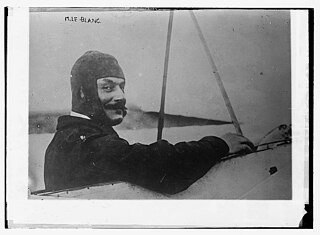This is a list of aviation-related events from 1910:

This is a list of aviation-related events from 1909:

Antoinette was a French manufacturer of light petrol engines. Antoinette also became a pioneer-era builder of aeroplanes before World War I, most notably the record-breaking monoplanes flown by Hubert Latham and René Labouchère. Based in Puteaux, the Antoinette concern was in operation between 1903 and 1912. The company operated a flying school at Chalons for which it built one of the earliest flight simulators.

A fly-in is a pre-arranged gathering of aircraft, pilots and passengers for recreational and social purposes.

The Blériot XI is a French aircraft of the pioneer era of aviation. The first example was used by Louis Blériot to make the first flight across the English Channel in a heavier-than-air aircraft, on 25 July 1909. This is one of the most famous accomplishments of the pioneer era of aviation, and not only won Blériot a lasting place in history but also assured the future of his aircraft manufacturing business. The event caused a major reappraisal of the importance of aviation; the English newspaper The Daily Express led its story of the flight with the headline "Britain is no longer an Island".

Claude Grahame-White was an English pioneer of aviation, and the first to make a night flight, during the Daily Mail-sponsored 1910 London to Manchester air race.

Ferdinand Léon Delagrange was a pioneering French aviator and sculptor. Léon was ranked as one of the top aviators in the world. On 30 December 1909 he had broken all speed records at Juvisy-sur-Orge in France in an attempt to win the Michelin Cup. He did not succeed in beating Henry Farman’s record for distance, but did establish a new distance record for monoplanes and a new world speed record. He covered 124 miles in 2 hours and 32 minutes, maintaining an average speed of approximately 45 miles an hour.
Trafford Park Aerodrome (Manchester) was the first purpose-built airfield in the Manchester area. Its large all-grass landing field was just south of the Manchester Ship Canal between Trafford Park Road, Moseley Road and Ashburton Road and occupied a large part of the former deer park of Trafford Hall. Today's Tenax Road runs north-south through the centre of the site of the old airfield, which was 0.7 miles northeast of today's Trafford Centre.

The Farman III, also known as the Henry Farman 1909 biplane, was an early French aircraft designed and built by Henry Farman in 1909. Its design was widely imitated, so much so that aircraft of similar layout were generally referred to as being of the "Farman" type.

The Los Angeles International Air Meet was among the earliest airshows in the world and the first major airshow in the United States. It was held in Los Angeles County, California, at Dominguez Field in present-day Carson, California. Spectator turnout numbered approximately 254,000 over 11 days of ticket sales. The Los Angeles Times called it "one of the greatest public events in the history of the West."

Henri Louis Rougier, was a French sportsman, racing cyclist, pioneer aeroplane pilot and sporting motorist. He is best remembered for his victory in the inaugural Monte Carlo Rally when he drove his Turcat-Méry from Paris to Monte Carlo, but he was also a regular competitor in both 'City to City' and Grand Prix races.

The 1910 London to Manchester air race took place between two aviators, each of whom attempted to win a heavier-than-air powered flight challenge between London and Manchester first proposed by the Daily Mail newspaper in 1906. The £10,000 prize was won in April 1910 by Frenchman Louis Paulhan.

Alfred Leblanc was a pioneer French aviator.

The Grande Semaine d'Aviation de la Champagne was an 8-day aviation meeting held near Reims in France in 1909, so-named because it was sponsored by the major local champagne growers. It is celebrated as the first international public flying event, confirming the viability of heavier-than-air flight.

The Gordon Bennett Aviation Trophy was an international airplane racing trophy awarded by James Gordon Bennett Jr., the American owner and publisher of the New York Herald newspaper. The trophy is one of three Gordon Bennett awards: Bennett was also the sponsor of an automobile race and a ballooning competition.

The pioneer era of aviation refers to the period of aviation history between the first successful powered flight, generally accepted to have been made by the Wright Brothers on 17 December 1903, and the outbreak of the First World War in August 1914.

























